

English language, alphabet and pronunciation. English is a West Germanic language related to Scots, Dutch, Frisian and German. with a significant amount of vocabulary from Old Norse, Norman French, Latin and Greek, and loanwords from many other languages.

Approximately 341 million people speak English as a native language and a further 267 million speak it as a second language in over 104 countries including the UK, Ireland, USA, Canada, Australia, New Zealand, South Africa, American Samoa, Anguilla, Antigua and Barbuda, Aruba, Bahamas, Barbados, Belize, Bermuda, Botswana, British Indian Ocean Territory, British Virgin Islands, Brunei, Cameroon, Canada, Cayman Islands, and the Cook Islands. A brief history of English Old English English evolved from the Germanic languages brought to Britain by the Angles, Saxons, Jutes and other Germanic tribes from about the 5th Century AD. These languages are known collectively as Anglo-Saxon or Old English, and began to appear in writing during the 5th century AD. More details of Old English Source: Transliteration of Ancient Egyptian. In the field of Egyptology, transliteration is the process of converting (or mapping) texts written in the Egyptian language to alphabetic symbols representing uniliteral hieroglyphs or their hieratic and Demotic counterparts.
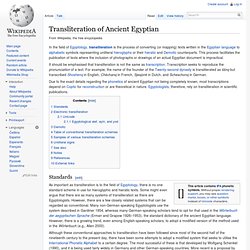
This process facilitates the publication of texts where the inclusion of photographs or drawings of an actual Egyptian document is impractical. Due to the exact details regarding the phonetics of ancient Egyptian not being completely known, most transcriptions depend on Coptic for reconstruction or are theoretical in nature. Egyptologists, therefore, rely on transliteration in scientific publications. Standards[edit] As important as transliteration is to the field of Egyptology, there is no one standard scheme in use for hieroglyphic and hieratic texts. Electronic transliteration[edit] Unicode[edit] Egyptological alef, ayin, and yod[edit] Three additional characters are required for transliterating Egyptian: Demotic[edit] Guide to reading Egyptian Hieroglyphics. Ancient Egyptian HieroglyphicsA simple guide to help you understand the ‘sacred text’ The Ancient Egyptian hieroglyphs (hieroglyphs meaning ‘sacred writing’ in Greek) has been used by the Ancient Egyptians for thousands of years.
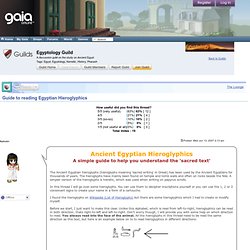
The hieroglyphs have mainly been found on temple and tomb walls and often on rocks beside the Nile. A simpler version of the hieroglyphs is hieratic, which was used when writing on papyrus scrolls. In this thread I will go over some hieroglyphs. You can use them to decipher inscriptions yourself or you can use the 1, 2 or 3 consonant signs to create your name in a form of a cartouche. The International Phonetic Alphabet - Audio Illustrations.
Www.tavultesoft.com/keyboarddownloads/%7B0B7E008C-0EEC-487E-B902-E5800A77CDBA%7D/Hieroglyphic Keyboard Help.pdf. Manuel de Codage. Hieroglyphic text basically consists of rows of signs arranged in horizontal lines or vertical columns.
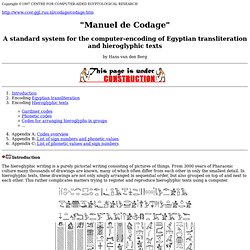
Within a row the signs are placed individually or grouped, upper having precedence over lower. The encoding system treats hieroglyphic text no different from the way the Ancient Egyptians and modern Egyptologists regarded their reading. So, is encoded in the order. Hieroglyphic Sign List of Gardiner, Hieroglyphs Alphabet, Ancient Egyptian transliteration. List of Egyptian hieroglyphs by common name: A–L. A List of Egyptian hieroglyphs by common name: A–L.

Uses Pyramid hieroglyph. Common names: A-L[edit] A[edit] S Tomb at neferchichi.com. The history of hieroglyphic writing So you want to write like an Egyptian, huh?
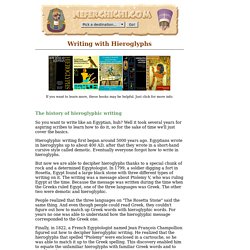
Well it took several years for aspiring scribes to learn how to do it, so for the sake of time we'll just cover the basics. Hieroglyphic writing first began around 5000 years ago. Egyptians wrote in hieroglyphs up to about 400 AD, after that they wrote in a short-hand cursive style called demotic. Eventually everyone forgot how to write in hieroglyphs. But now we are able to decipher hieroglyphs thanks to a special chunk of rock and a determined Egyptologist. Learn to read Egyptian hieroglyphs! Dictionary. My list of academic heresies is presented below.

Many corrections to current transliteration were taken directly from the xenoglossy recorded on gramophone and in the book "Egyptian Miracle" by Frederic H. Wood. See this link for more information on the otherworldly source for some of the pronunciations on this page. F - Parts of the Mammal to this group 53 hieroglyphics count. F1 abbreviation for cow (jach) F2 Determinative for fury (djnd) F3 sound sign for At F4 sound sign for achAt.
G - Birds This group contains 54 hieroglyphics and is also one of the most extensive. G1 Egyptian vulture. G26 Determinative for Ibis (hb), (ibisartiger) God Thot (dỉachwtỉ) G26a Determinative for Ibis (hb), (ibisartiger) God Thot (dỉachwtỉ) G27 Phonogram for dschr Determinative for Flamingo (dschr) G28 Phonogram for gm G29 Phonogram for bA. [edit] H - Parts of Birds. Jim Loy's Egyptian Hieroglyphics and Egyptology Page. Go to my home page Go to my Egyptology page, without a background image. The signs on the right wish you life, prosperity, and health. These pages have won the Open Directory Cool Site award. (Yahoo) lists this page as one of their recommended sites. These pages are dedicated to Carol Hagelstein, wherever she is. My Egyptian Hieroglyphic Dictionary Egyptian Hieroglyphic Alphabet Your Name In Egyptian Hieroglyphics (loads slowly) Articles about the Egyptian language: Other Egyptology articles: These are in my Book Reviews: These are in my Pseudoscience pages:
Monuments of Ancient Egypt: Great Pyramid Complex of Giza. Like its successors in Ancient Egypt, the great pyramid of Giza was accompanied by all of the standard elements of a pyramid complex.
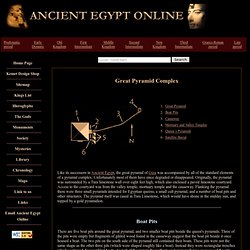
Unfortunately most of them have since degraded or disappeared. Originally, the pyramid was surrounded by a Tura limestone wall over eight feet high, which also enclosed a paved limestone courtyard. Access to the courtyard was from the valley temple, mortuary temple and the causeway. Flanking the pyramid there were three small pyramids intended for Egyptian queens, a small cult pyramid, and a number of boat pits and other structures. Ancient Egyptian scripts (hieroglyphs, hieratic and demotic) Origins of Egyptian Hieroglyphs The ancient Egyptians believed that writing was invented by the god Thoth and called their hieroglyphic script "mdju netjer" ("words of the gods").

The word hieroglyph comes from the Greek hieros (sacred) plus glypho (inscriptions) and was first used by Clement of Alexandria. The earliest known examples of writing in Egypt have been dated to 3,400 BC. Hieroglyphs. Hieroglyphs. . . . . .A brief description.
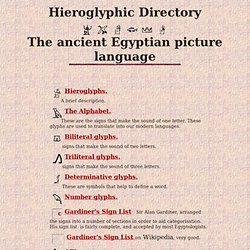
The Alphabet. . . . . .These are the signs that make the sound of one letter. These glyphs are used to translate into our modern languages. Systems Font Foundry: Fonts for the Ages.